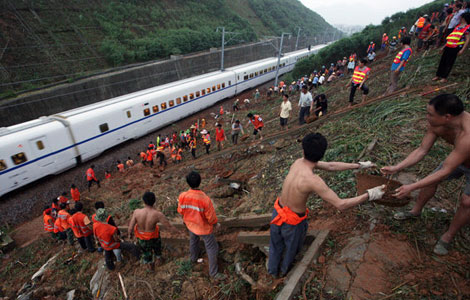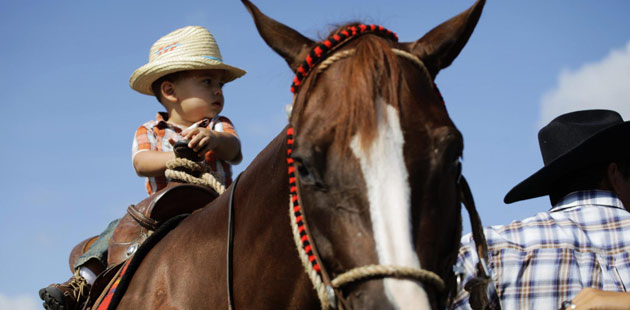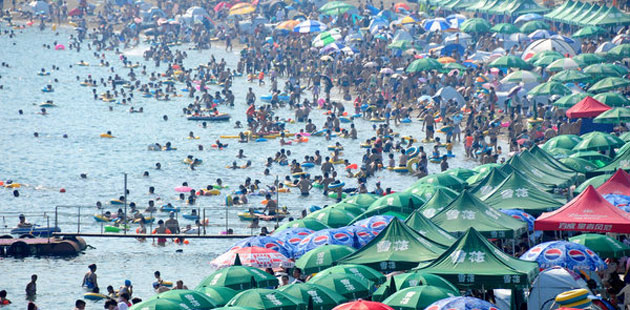Kindergartens' closure reflects migrants' plight
Updated: 2011-09-02 21:44
(Xinhua)
|
|||||||||||
"Who can take care of my child?"
The closure of the Xiyangyang Kindergarten has brought great anguish to many migrant workers in the town.
"I asked my son to write his name repeatedly. That was the only assignment I could think of," Zhang Yanbing said.
A dozen parents said they were not informed of any resettlement plan and raised the same question, "Who can take care of my child? "
"It's certain that the problem can hardly be solved in a short period of time," Yang Min said.
With a migrant population of 100,000 in addition to 24,000 local residents, Xihongmen township has only three licensed kindergartens.
Seventeen kindergartens in the town, which have property ownership certificates but lack operating licenses, were exempt from forced closure, Yang said.
"If all the illegal kindergartens were closed, we would have no place to resettle the displaced children," Yang said.
The government has planned to matriculate the students of closed kindergartens into the three licensed kindergartens and the 17 remaining illegal ones. New kindergartens are also being constructed to accommodate the children, according to Yang.
However, many parents can not afford to wait.
"I have to find a new kindergarten for my daughter as soon as possible, or I have no time to restock the shelves (for my shop)," said 28-year-old Hu Xiaomei from Central China's Henan province. She and her husband run a cosmetics shop in the town.
"I'm going to lose my job! How can I take my girl to work?" said a 30-year-old mother surnamed Zheng.
Close the schools, lose the migrants?
The shutdown of the kindergartens in Xihongmen township followed the closures of another 24 schools for the children of migrant workers in Beijing earlier this month.
More than 14,000 children, mostly in the city's outlying Haidian, Chaoyang and Daxing districts, were affected by the closures.
Besides safety concerns, Wang Xiaomin speculated that another reason leading to her kindergarten's closure was that the local authorities want the migrant people to leave.
"A local official once told me that the migrant workers have become a heavy burden for Beijing, especially in Daxing District. But I think we've contributed a lot to the city. You see the skyscrapers in the city proper? They're the sweat and toil of migrant workers," Wang said.
The results of China's sixth nationwide census show that Beijing has about 19.6 million permanent residents, while the nation's capital aims to bring its population within 18 million in 2020.
The migrant population made up 35.9 percent of Beijing's total population in 2010, up from 18.9 percent in 2000.
Due to restrictions in the country's household registration (hukou) system, migrant workers cannot enjoy the same treatment in terms of education, medical care, social insurance as local residents.
"The emergence of kindergartens and schools for migrant children is a self-saving effort resulting from scarce public educational resources. It's wise for the government to help the schools improve their facilities and quality of education," said Yang Dongping, president of the 21st Century Education Development Research Institute, a nongovernmental organization dedicated to improving education in China.
If the government decides to close illegal schools, they should come out with an effective resettlement plan in advance, he said.
Some migrant workers have said they had to pay extra fees to enroll their children in government-subsidized kindergartens.
"Beijing shouldn't try to control its population by simply raising the threshold for entering the city," said Lu Jiehua, a sociology professor with Peking University.
China will see a faster pace of urbanization from 2011 to 2015, Lu said.
"I'm concerned that population control policies could deprive migrant workers of their rights, which may lead to major social conflicts."
Hot Topics
Libya conflict, Gaddafi, Oil spill, Palace Museum scandal, Inflation, Japan's new PM, Trapped miners, Mooncake tax, Weekly photos, Hurricane Irene
Editor's Picks

|

|

|

|

|

|






